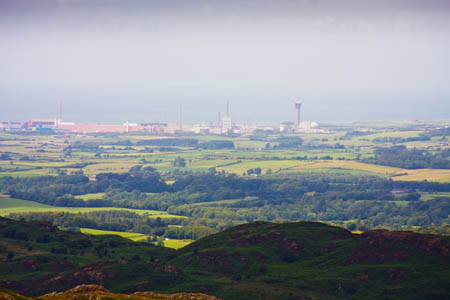The coalition Government will not go ahead with plans to build two new nuclear power stations at sites on the Cumbrian coast, but a further reactor will be built at the existing Sellafield nuclear facility if Parliament agrees.
The decision to drop the planned two new power stations was welcomed by both the Friends of the Lake District and the Campaign for National Parks.
And the Lake District National Park Authority chief executive Richard Leafe tweeted: “Pleased to see the threat of two new nuclear power stations close to the park has been lifted.”
But the CNP warned consideration should be given to burying cables or routing them under the sea from the new power station at Sellafield and also at Wylfa near the Snowdonia national park.
Energy Secretary Chris Huhne made the announcement to Parliament today, at the same time abandoning plans for a Severn Barrage which supporters said would supply five per cent of the country’s electricity needs.
Welcoming the Cumbrian plans, CNP’s head of policy Ruth Chambers said: “We commend the Government on its ruling that Kirksanton and Braystones are not suitable for nuclear power stations.
“Had they gone ahead they would have had a massive impact on the Lake District national park, not only through their bulk and industrial nature, but also because of lines of pylons that would have had to be built to transport the electricity to centres of population.
“The choice of greenfield sites on the doorstep of one our best known and most iconic landscapes made no sense in environmental or economic terms and we are delighted that this threat has been removed.”
She added: “We welcome the publication today of the Government’s proposed national energy policy statements for re-consultation and will be making the case for these to clarify that grid connections to new nuclear power stations must be considered at the earliest opportunity so that their potential impacts can be considered fully and all options explored.
“In the case of Wylfa and Sellafield that must include a serious look at undergrounding and offshore submarine cables so that harmful impacts on the national parks can be avoided.”
Jack Ellerby, Friends of the Lake District policy officer responsible for energy said: “The development of two huge new greenfield sites on the West Cumbrian coast for new power stations was a step too far.
“National paper headlines of ‘Nuke District’ reflected the damage these sites would have done, not only to the landscape, but also to the Lake District brand upon which the local economy depends. The generation of new energy sources within Cumbria should not be a trade off with the spectacular landscape and natural environment.”
Part of the Kirksanton site lies within a flood risk zone and the planned plant would have been close to the Duddon estuary special protection area and site of special scientific interest. The Silver Tarn, Hollas and Harnsey Mosses SSSI is close to the Braystones site, which lies just 6km (3¾ miles) from the start of the popular Wainwright’s Coast to Coast Walk at St Bees Head.
A report prepared in January for the Lake District National Park Authority recommended support for the Sellafield extension, but opposition to the Kirksanton and Braystones plans.

Tony Greaves
19 October 2010"but a further reactor will be built at the existing Sellafield nuclear facility if Parliament agrees."
This is not exactly true. The eight sites have been listed as sites where applications for consent to develop will be appropriate. There is no guarantee that any of them will go ahead - that depends on whether anyone comes forward with a proposal (and application for consent) to build them, and whether development consent (ie planning permission) is then given once an application is made. "Parliament" will have no say in that decision.
The listing of sites is part of a National Policy Statement on nuclear power and part of the new planning system for major infrastructure projects set up under the last government and passed by Parliament in the Planning Act 2008.
The new government is proposing to make some changes to this legislation (notably to put the final decision in the hands of the Secretary of State for Communities and Local Government) but the essentials will remain in place.
It is rather unlikely that all eight sites will see new nuclear power stations. Which ones may go ahead is a matter of conjecture though the Sellafield site may be a frontrunner as a result of the existing installations on the site. On the other hand there are some obvious problems.
Tony Greaves